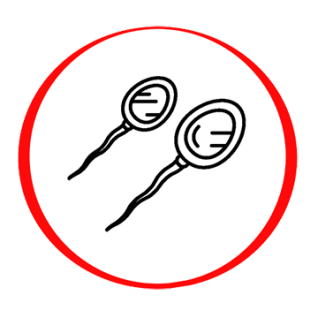
Panel of 7 Genital Ulcer Pathogens from Urine (Herpes simplex 1 (HSV-1), Herpes simplex 2 (HSV-2), Haemophilus ducreyi, Cytomegalovirus (CMV), Chlamydia trachomatis LGV, Treponema pallidum, Varicella zoster virus (VZV)) by PCR method
60.00€
The validity period for online orders: 3 months from the date of purchase.
Herpes simplex 1/2 infections are transmitted through contact with HSV herpes sores, mucosal surfaces, genital secretions, or oral secretions. HSV-1 and HSV-2 can be released from normal-appearing oral or genital mucosa or skin. Typically, a person can only become infected with HSV-2 during genital contact with someone who has an HSV-2 infection. However, oral-genital contact with a person infected with oral HSV-1 can lead to genital HSV-1 infection. Transmission most often occurs with an infected partner who does not have visible lesions and may not know they are infected. Most individuals infected with HSV are asymptomatic or have very mild symptoms that go unnoticed or are mistaken for another skin condition. When symptoms occur, they typically appear as one or more blisters on or around the genitals, rectum, or mouth. The average incubation period for an initial herpes infection is 2 to 12 days after exposure. The blisters break and leave painful sores that may take two to four weeks to heal. These symptoms are referred to as the first herpes 'outbreak' or episode. Clinical manifestations of genital herpes vary between the initial and recurrent (i.e., subsequent) outbreaks. The first outbreak is often associated with a longer duration of lesions, increased viral shedding (which increases the likelihood of HSV transmission), and systemic symptoms, including fever, body aches, swollen lymph nodes, or headache.
Treponema pallidum is the bacterium that causes syphilis, a chronic systemic infection that can progress through four stages. Primary symptoms occur between 10 to 90 days, usually around 3 weeks (21 days). The primary symptom is a painless sore at the infection site. The sore may be hard to notice and often disappears within 3–6 weeks without treatment but may periodically recur. Early diagnosis and treatment are essential to prevent the infection from progressing.
Chlamydia trachomatis LGV - one of the diseases caused by the chlamydia bacterium is lymphogranuloma venereum (LGV). LGV is a sexually transmitted infection caused by specific Chlamydia trachomatis serovars (L1, L2, L3). The primary route of transmission is through sexual contact: vaginal, anal, and oral. The initial symptom is small, painless blisters or sores in the genital or rectal area, which often go unnoticed. These appear 3-30 days after infection. If untreated, chronic inflammation, lymph node, rectal damage, and reproductive system problems may develop.
Cytomegalovirus (CMV) is a member of the herpesvirus family that causes chronic infections. Though CMV is not typically considered a specific sexually transmitted infection, it can be transmitted through sexual contact. Most healthy individuals infected with CMV experience no symptoms, but some may experience symptoms similar to mononucleosis (fever, fatigue, muscle aches, sore throat, swollen lymph nodes). The incubation period for CMV usually ranges from 3 to 12 weeks after exposure. Most healthy people experience an asymptomatic or mild infection, after which the virus remains latent in the body and can be reactivated in the future, particularly if the immune system is weakened. If a pregnant woman is infected with CMV for the first time during pregnancy, the virus can be transmitted to the fetus, potentially leading to congenital CMV infection with serious consequences.
Haemophilus ducreyi is a bacterium that causes sexually transmitted infections characterized by painful ulcerative disease. The infection begins as a small, red bump on the genital or anal area, which quickly turns into a painful open sore. The incubation period is 4 to 10 days after infection. If untreated, the infection causes significant pain and discomfort, especially during urination and sexual intercourse. It is recommended to test when genital ulcers are present but negative results for Treponema pallidum and HSV 1/2 are obtained.
Varicella zoster virus can cause Herpes zoster disease, which manifests as pain, burning sensation, itching, and rash. The incubation period from viral reactivation to symptom onset can be from a few days to several weeks. Initial symptoms often include pain or discomfort before the rash appears.

Reference: 19585
60.00€






